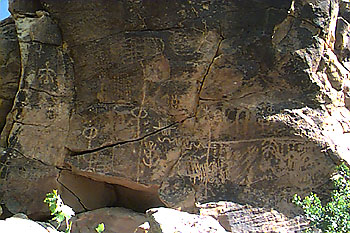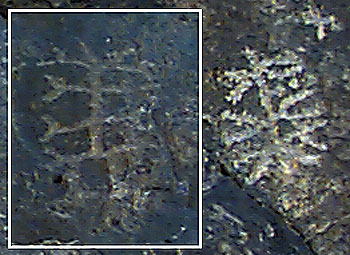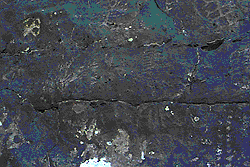
|
The Mystery of Ancient America's
ViewZone will attempt to give you all the details. Our next map location takes us to what was once a natural reservoir, since fortified with a dam to control periodic flooding. Although many old sites could possibly be under water now, several very old rock cliffs surround the reservoir. These rocks are extremely black and show signs of cracking and breaking away from the face of the cliff. 
Many compound symbols can be seen. At this location there were many dot patterns. In LaVan Martineau's system of the universal language these would be interpreted as meaning rain or small particles. But these dots seemed to be different. They appeared to be arranged in neat rows and columns, as if perhaps keeping a tally of events. Some had from six to ten rows, with any number of dots in each row. It was not possible to determine if the dots were made at the same time, or added to over a long period. The surface was just too worn to guess. The thought occured that this might be measuring a life span, but we were reminded that it was rare for the ancestral humans to have lived beyond 35 or 40 - and many of the "tallys" had well over seventy dots in them. Perhaps these were not years, as we know them, but seasons or lunar cycles. Again, we can only guess.  While the elk wall had many circles on its tree-like compound symbols, this location had an abundance of semi-circular "branches." When they did have a shape attached to the branches it was frequently in the shape of a "Y." But this was only true to the naked eye.
These older and heavily patinated petroglyphs show the same circular patterns and tree-like arrangements we had seen on the "elk" wall. We decide that we should look for these in each site that we have photographed. But that will have to wait. We are off to yet another destination and an encounter with the past. This time in the Oklahoma panhandle.
|

 When we later examined the digital images for a pattern of small pits, we were able to play a sort of "connect the dots" game. By doing this, many of the older shapes became visible. We noticed that the visible patterns appeared to us to be parts of much older and more intricate patterns that had been partially re-pecked. These older petroglyphs are covered by black patination from thousands of years of weathering. An example of these patterns can be seen in the animation below. This is just a partial outlining of what is hidden on this four foot wide area of an enormous boulder.
When we later examined the digital images for a pattern of small pits, we were able to play a sort of "connect the dots" game. By doing this, many of the older shapes became visible. We noticed that the visible patterns appeared to us to be parts of much older and more intricate patterns that had been partially re-pecked. These older petroglyphs are covered by black patination from thousands of years of weathering. An example of these patterns can be seen in the animation below. This is just a partial outlining of what is hidden on this four foot wide area of an enormous boulder.